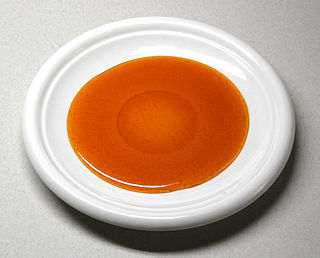
Glucose is a sugar with the molecular formula C6H12O6. Glucose is overall the most abundant monosaccharide, a subcategory of carbohydrates. Glucose is mainly made by plants and most algae during photosynthesis from water and carbon dioxide, using energy from sunlight, where it is used to make cellulose in cell walls, the most abundant carbohydrate in the world.

Hypoglycemia, also called low blood sugar, is a fall in blood sugar to levels below normal, typically below 70 mg/dL (3.9 mmol/L). Whipple's triad is used to properly identify hypoglycemic episodes. It is defined as blood glucose below 70 mg/dL (3.9 mmol/L), symptoms associated with hypoglycemia, and resolution of symptoms when blood sugar returns to normal. Hypoglycemia may result in headache, tiredness, clumsiness, trouble talking, confusion, fast heart rate, sweating, shakiness, nervousness, hunger, loss of consciousness, seizures, or death. Symptoms typically come on quickly.
Hydrolysis is any chemical reaction in which a molecule of water breaks one or more chemical bonds. The term is used broadly for substitution, elimination, and solvation reactions in which water is the nucleophile.

Starch or amylum is a polymeric carbohydrate consisting of numerous glucose units joined by α-(1→4)-D glycosidic bonds. This polysaccharide is produced by most green plants for energy storage. Worldwide, it is the most common carbohydrate in human diets, and is contained in large amounts in staple foods such as wheat, potatoes, maize (corn), rice, and cassava (manioc).

Caramel is an orange-brown confectionery product made by heating a range of sugars. It can be used as a flavoring in puddings and desserts, as a filling in bonbons, or as a topping for ice cream and custard.

Glycaemia, also known as blood sugar level, blood sugar concentration, or blood glucose level is the measure of glucose concentrated in the blood of humans and other animals. Approximately 4 grams of dissolved glucose, a simple sugar, is present in the blood plasma of a 70 kg (154 lb) human at all times. The body tightly regulates blood glucose levels as a part of metabolic homeostasis. Glucose is stored in skeletal muscle and liver cells in the form of glycogen; in fasting individuals, blood glucose is maintained at a constant level at the expense of glycogen stores in the liver and skeletal muscle.

Caramelization is a process of browning of sugar used extensively in cooking for the resulting sweet nutty flavor and brown color. The brown colors are produced by three groups of polymers: caramelans (C24H36O18), caramelens (C36H50O25), and caramelins (C125H188O80). As the process occurs, volatile chemicals such as diacetyl are released, producing the characteristic caramel flavor.

Amylose is a polysaccharide made of α-D-glucose units, bonded to each other through α(1→4) glycosidic bonds. It is one of the two components of starch, making up approximately 20–30%. Because of its tightly packed helical structure, amylose is more resistant to digestion than other starch molecules and is therefore an important form of resistant starch.

Sugar alcohols are organic compounds, typically derived from sugars, containing one hydroxyl group (–OH) attached to each carbon atom. They are white, water-soluble solids that can occur naturally or be produced industrially by hydrogenating sugars. Since they contain multiple –OH groups, they are classified as polyols.

Cotransporters are a subcategory of membrane transport proteins (transporters) that couple the favorable movement of one molecule with its concentration gradient and unfavorable movement of another molecule against its concentration gradient. They enable coupled or cotransport and include antiporters and symporters. In general, cotransporters consist of two out of the three classes of integral membrane proteins known as transporters that move molecules and ions across biomembranes. Uniporters are also transporters but move only one type of molecule down its concentration gradient and are not classified as cotransporters.
Disaccharidases are glycoside hydrolases, enzymes that break down certain types of sugars called disaccharides into simpler sugars called monosaccharides. In the human body, disaccharidases are made mostly in an area of the small intestine's wall called the brush border, making them members of the group of "brush border enzymes".

Gentiobiose is a disaccharide composed of two units of D-glucose joined with a β(1->6) linkage. It is a white crystalline solid that is soluble in water or hot methanol. Gentiobiose is incorporated into the chemical structure of crocin, the chemical compound that gives saffron its color. It is a product of the caramelization of glucose. During a starch hydrolysis process for glucose syrup, gentiobiose, which has bitterness, is formed as an undesirable product through the acid-catalyzed condensation reaction of two D-glucose molecules. One β-D-glucose unit elongation of the bitter disaccharide reduces its bitterness by a fifth, as determined by human volunteers using the trimer, gentiotriose. Gentiobiose is also produced via enzymatic hydrolysis of glucans, including pustulan and β-1,3-1,6-glucan.

In enzymology, aldose reductase is a cytosolic NADPH-dependent oxidoreductase that catalyzes the reduction of a variety of aldehydes and carbonyls, including monosaccharides. It is primarily known for catalyzing the reduction of glucose to sorbitol, the first step in polyol pathway of glucose metabolism.
Depolymerization is the process of converting a polymer into a monomer or a mixture of monomers. This process is driven by an increase in entropy.

Isomaltose is a disaccharide similar to maltose, but with a α-(1-6)-linkage instead of the α-(1-4)-linkage. Both of the sugars are dimers of glucose, which is a pyranose sugar. Isomaltose is a reducing sugar. Isomaltose is produced when high maltose syrup is treated with the enzyme transglucosidase (TG) and is one of the major components in the mixture isomaltooligosaccharide.

Kojibiose is a disaccharide. It is a product of the caramelization of glucose. It is also present in honey.

Nigerose, also known as sakebiose, is an unfermentable sugar obtained by partial hydrolysis of nigeran, a polysaccharide found in black mold, but is also readily extracted from the dextrans found in rice molds and many other fermenting microorganisms, such as L. mesenteroides. It is a disaccharide made of two glucose residues, connected with a 1->3 link. It is a product of the caramelization of glucose.
Sophorose is a disaccharide, a dimer of glucose. It differs from other glucose dimers such as maltose in having an unusual β-1,2 bond. It was isolated in 1938 from pods of Sophora japonica. It is a component of sophorolipids. It is a product of the caramelization of glucose.
Timothy S. Fisher is an American educator, engineer and expert in the application of nanotechnologies. He is a former professor of mechanical engineering at the School of Mechanical Engineering, Purdue University and Director, Nanoscale Transport Research Group-Purdue University. He currently teaches at the University of California, Los Angeles. He took his Bachelor of Science and doctorate at Cornell University in 1991 and 1998, respectively. Fisher became the chair of mechanical and aerospace engineering department at University of California, Los Angeles, starting July 1, 2018.

In enzymology, a xylose isomerase is an enzyme that catalyzes the interconversion of D-xylose and D-xylulose. This enzyme belongs to the family of isomerases, specifically those intramolecular oxidoreductases interconverting aldoses and ketoses. The isomerase has now been observed in nearly a hundred species of bacteria. Xylose-isomerases are also commonly called fructose-isomerases due to their ability to interconvert glucose and fructose. The systematic name of this enzyme class is D-xylose aldose-ketose-isomerase. Other names in common use include D-xylose isomerase, D-xylose ketoisomerase, and D-xylose ketol-isomerase.















